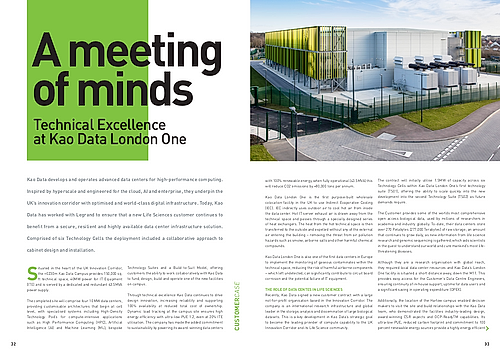
A meeting of minds - technical excellence at Kao Data London One
Kao Data develops and operates advanced data centers for high-performance computing. Inspired by hyperscale and engineered for the cloud, AI and enterprise, they underpin the UK’s innovation corridor with optimised and world-class digital infrastructure. Today, Kao Data has worked with Legrand to ensure that a new Life Sciences customer continues to benefit from a secure, resilient and highly available data center infrastructure solution. Comprised of six Technology Cells the deployment included a collaborative approach to cabinet design and installation.
Situated in the heart of the UK Innovation Corridor, the +£230m Kao Data Campus provides 150,000 sq. ft technical space, 40MW power for IT Equipment (ITE) and is served by a dedicated and redundant 43.5MVA power supply.
The completed site will comprise four 10 MW data centers, providing customisable architectures that begin at cell level, with specialised systems including High-Density Technology Pod’s for compute-intensive applications such as High Performance Computing (HPC), Artificial Intelligence (AI) and Machine Learning (ML); bespoke Technology Suites and a Build-to-Suit Model, offering customers the ability to work collaboratively with Kao Data to fund, design, build and operate one of the new facilities on campus.
Through technical excellence Kao Data continues to drive design innovation, increasing reliability and supporting 100% availability at reduced total cost of ownership. Dynamic load tracking at the campus site ensures high energy-efficiency with ultra-low PUE 1.2, even at 20% ITE utilisation. The company has made the added commitment to sustainability by powering its award-winning data centers with 100% renewable energy, when fully operational (43.5MVA) this will reduce CO2 emissions by +80,000 tons per annum.
Kao Data London One is the first purpose-built wholesale colocation facility in the UK to use Indirect Evaporative Cooling (IEC). IEC indirectly uses outdoor air to cool hot air from inside the data center. Hot IT server exhaust air is drawn away from the technical space and passes through a specially designed series of heat exchangers. The heat from the hot technical space is then transferred to the outside and expelled without any of the external air entering the building – removing the threat from air pollution hazards such as smoke, airborne salts and other harmful chemical compounds.
Kao Data London One is also one of the first data centers in Europe to implement the monitoring of gaseous contaminates within the technical space, reducing the risk of harmful airborne components – which left undetected, can significantly contribute to circuit board corrosion and the potential failure of IT equipment.
THE ROLE OF DATA CENTES IN LIFE SCIENCES
Recently, Kao Data signed a new customer contract with a large not-for-profit organisation based in the Innovation Corridor. The company is an international research infrastructure and global leader in the storage, analysis and dissemination of large biological datasets. This is a key development in Kao Data’s strategic goal to become the leading provider of compute capability to the UK Innovation Corridor and its Life Science community.
The contract will initially utilise 1.5MW of capacity across six Technology Cells within Kao Data London One’s first technology suite (TS01), offering the ability to scale quickly into the new development into the second Technology Suite (TS02) as future demands require.
The Customer provides some of the worlds most comprehensive open access biological data, used by millions of researchers in academia and industry globally. To-date, their data centers store over 270 Petabytes (277,000 Terabytes) of raw storage; an amount that continues to grow daily, as new information from life science research and genomic sequencing is gathered, which aids scientists in the quest to understand our world and cure mankind’s most life-threatening diseases.
Although they are a research organisation with global reach, they required local data center resources and Kao Data’s London One facility is situated a short distance away, down the M11. This provides easy access for the Customer’s Data Centre Engineers, ensuring continuity of in-house support, uptime for data users and a significant saving in operating expenditure (OPEX).
Additionally, the location of the Harlow campus enabled decision makers to visit the site and build relationships with the Kao Data team, who demonstrated the facilities industry-leading design, award-winning CSR aspects and OCP-ReadyTM capabilities. Its ultra-low PUE, reduced carbon footprint and commitment to 100 percent renewable energy sources provide a highly energy efficient environment with a low cost of operation, which played an equally important factor in the selection process.
CABINET COLLABORATION – A KEY TO SUCCESS
Kao Data was one of six companies invited by the Life Science organisation to attend a workshop ahead of the final awarding of the data center contract, where its consultative approach to pre-sales, allied to its partnering approach with both clients and its supply chain, was a further, significant differentiator. Additionally, Kao Data was able to meet the power requirement for 15kW per rack and higher in some instances.
After they were awarded the contract, Kao Data visited the client’s existing data center to gain insight and understanding into what was required from the new facility. Importantly, the company was flexible to new approaches when it came to the design of the new data center solution.
FLEXIBILITY KEY HALLMARK
Indeed, flexibility was a key hallmark of the complete project, as demonstrated by the relationship between Kao Data and its chosen cabinet supplier, Minkels. Working with its chosen data center ‘fit out’ design, build and installation partner, Datalec Precision Installations, Kao Data placed an order for 154 cabinets, each 50U or approximately 2400mm high by either 600 or 800mm wide by 1200mm deep, split across the six enclosed hot aisle technology cells.
WORKING TOGETHER
Crucially, the transparency of both Minkels and Datalec in working with Kao Data highlighted a potential issue around the manufacturing and delivery of the cabinets. All three organisations worked together to finalise the bespoke cabinet design, aware that this needed to be completed to a deadline in order to ensure that the cabinets could be manufactured and delivered on site ahead of the factory’s summer shutdown. In actual fact, the order was delivered to Kao Data three days ahead of the deadline.
CHOOSEN SOLUTION
Design-wise, bearing in mind the customers not-for-profit status and the need to demonstrate value for money, it was agreed that the individual cabinets would be supplied without doors. The Minkels rack airflow system, combined with the use of blanking panels, enabled this cost-saving measure to be implemented.
The Minkels cabinets form the main part of what is an enclosed hot aisle solution with vertical clear panels, each 1200mm in height, mounted on the rear of each cabinet and across the hot aisle end doors. The enclosures incorporate the existing lighting trunking and ceiling suspension grid.
The Minkels cabinets are 50U high. The 600mm wide cabinets are used for the servers, while the 800mm cabling units sit mid-row, configured to allow cross cabling.
All of the cabinets are configured to include an air seal kit, so there is no cross-contamination from the cool air delivery within the data hall and the hot air exhaust from the enclosed aisles.
An innovative feature of this Kao Data project was the roof system, a bespoke variation of the Minkels Upstand solution. Clear, polycarbonate, fluted panels sit on a standard Minkels roof system and are secured to the ceiling tiles with a U-section frame, housing 10mm securing bolts, secured into the ceiling support fixing channels.
Additionally, the cabinets were able to adapt well to the requirements of being positioned on a solid concrete floor (as opposed to a raised floor design). The cabinets’ seals and skirting edges are good for levelling, with foam used to create the sealed aisle containment. Overall, the Minkels cabinets provide the necessary flexibility to be levelled on a power floated, concrete data center floor.
Within the suite, the cabling is run overhead in a two-tier, colour-coordinated basket tray, with the PDUs also being colour-coordinated for each of the 3 distributed redundant power supplies – A, B and C. The doors located at the end of the aisles are smooth in their opening and soft-close and are designed specifically to work well with the Minkels cabinets and have been branded with the customers logo.




